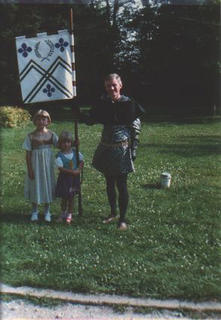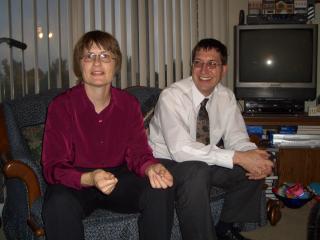
Not long ago, I was reviewing my 20+ years of garb with a dissatisfied eye. Cotehardies, bliauts, houppelandes, shirts, hose. Yuck. None of it quite as period as I’d like, much that doesn’t quite fit anymore. I tried to assemble an outfit using the splendid new 14th century separate hosen I’d ordered some time ago from
Revival Clothing. Fit was great, but they sent me two left legs. Sigh.
Not knocking Revival, a supplier of which I have a high opinion – their shoes are great. I’m sure they’ll replace one of the legs with a right after Pennsic.
In short, I need to retool. I’ve fallen well behind the curve. Aileran O Faelain is substantially better dressed than I am, I noticed at the last event I attended. I have a reputation to uphold, after all.
My first garb was an electric blue polyester t-tunic, which, with black hose, drew “Hey, why are you dressed like
Dr. Strange?” comments 23 years ago at
UM-Flint. Well, that wasn’t intentional. I upgraded to Norman 12th century bliauts shortly thereafter, and moved to houppelandes and cotehardies when I became more interested in the 14th and 15th centuries. I wore a blue velvet cotehardie at
Stormvale’s elevation ceremony that made heads turn everywhere I went at the event in 1988. (That was a bit revelatory – I had never parted a crowd like the Red Sea before. Nice feeling. Good for the ego, which possibly I don’t need.)
In civilian life, I don’t stand out, although I prefer not to look like a 16 year old circa 1978 as so many of my old friends do. (You know who you are.) Lately, I’ve worn sports jackets whenever I could get away with it, and have been known to wear hats. Not baseball caps. Real hats. But curiously, I always had the notion that a medieval gentleman (a “man of substance,” as Geirmundr and I both like to say) ought to look the part.
Not really a conventional idea in Stormvale, I have to say. I’ve worn rather ordinary cotehardies in Stormvale camp at Pennsic and drawn curious questions as to why I was dressed up. (I’ve usually managed to avoid saying “Well, because I’m not doing my peasant impression today, why do you think?” and instead said something modest, like “What, this old thing?”)
I had a vague notion of this for many years, but a couple of amusing incidents brought it home in the 1990s. My sister attended a Stormvale revel once and afterwards asked me why I was dressed differently from all the other men attending. I said I wasn’t sure what she meant, and it transpired that she had noticed that every other man at the revel was wearing a kilt. I suppose I must have been wearing the usual 14th century cote of some sort, not necessarily too dressy. That was Stormvale in those days. But it wasn’t just because most of the guys who were there were Scots. There was no hiding the fact that kilts are garb for “real men”. Apparently it takes nerve to wear what might otherwise be regarded as a dress in the present time. Nerve I had in sufficient quantity.
In the late 1990s, I was at a big event, probably a Coronation, in the Flame. I fought during the day (got a funny story or two there for another time), and at some point in late afternoon was on the way back from the car in a nearby parking ramp, wearing fairly spiffy garb for the evening, perhaps the third outfit of the day, counting armor. Countess Ariake walked by, made a sort of tut-tut noise and said “Balian, you’re such a clothes horse.” Not unkindly, you understand, but just an observation.
Now, Ariake might have blinded someone not accustomed to the splendor of her garb at just that moment, so this was perhaps a case of the pot calling the kettle black. On the whole, I decided it was a compliment. I embraced my role as Stormvale’s male clothes horse.
I’m not the only one, quite. Gareth Lynn Crestwick dressed quite well in the early 90s, and the aforementioned Aileran is often quite spiff. Breac Mac Finnein has been known to do the Tudor thing quite well. Skalla Geirmundr Ulfsson has on occasion dressed in a manner suitable to his status.
But I seem to be the only local lord who has a reputation in this regard. I was wearing an Order of the Willow medallion at an event a number of years ago and heard the comment that I must have gotten it for garb. “Oh, no, cooking,” I said, cheerfully, to a somewhat nonplussed look. (This is quite funny. I actually have made a little garb, but I’m no good at it. Unlike Geirmundr, who is quite skilled in this regard, I can’t even operate a sewing machine without someone standing over me supervising. My wife Melisande has made most of my garb, although Eschiva of Jebala made a couple of very nifty outfits for me, along with helping me make a velvet coat of plates that sometimes caused jaws to drop when I entered the lists. That armor got me my very favorite compliment, the remark that I looked like I had just stepped out of a museum exhibit. I know for a fact that armor won me some bouts from sheer panache.)
So, why do this? Well, some years ago, Stormvale’s Pennsic camp had a party during which men were expected to wear “danglies”, or loincloths. (Long story, and a somewhat funny one, although I was exasperated at the time.) An attempt was made to persuade me to comply with the dress code at a future party of this kind, to the degree of a promise of a velvet loincloth embroidered with my arms and a matching “squid hat”, Stormvale’s fond term for my early 15th century chaperon. I was flattered, but this made me seriously consider what I was up to in the SCA. After some reflection, I thought that the whole point of why I was in the organization was to emulate a late medieval man of good birth. A gentleman. In the Middle Ages, a gentleman might perhaps appear in public in nothing more than a shirt or in the all-together – when suitable. But generally speaking, he would naturally dress in fine clothing that was suitable to his station. He would never appear in a curious loincloth, unless perhaps for a theatrical effort, and I’m not sure that isn’t more of a 17th century thing.
In short, if I’m going to do this, why not do it right?
So now I am feeling somewhat out of the loop on garb. Melisande has heard my plea for new shirts and cotehardies with an agreeable air, and Eron Crowfford and Terryl MacAodhagain made vague noises about a willingness to supply me with some sort of garb if I took on the seneschal’s office again (a passing comment, but I don’t propose to forget it!), so hopefully I will feel suitably appareled again soon.
Vanity, of course, but there you are. I have a notion that something in blue or green, possibly velvet, embroidered all over with golden bees might do the trick. I’ll need a hat, of course, and what will I do for a belt…?









